Doncaster, West Riding of Yorkshire
Up to 1834
The earliest proposal to establish a workhouse in Doncaster dates from 1719, when a group of a dozen subscribers, consisting of the corporation and local landed gentry, provided £558 to purchase what the borough corporation act book describes as 'a workhouse or a house of maintenance, to get the poor of this town to work, who have become very numerous'. Despite this, it appears that a 'house of maintenance' for the poor was not in existence until about 1730, located in a house built originally by Alderman Pell.
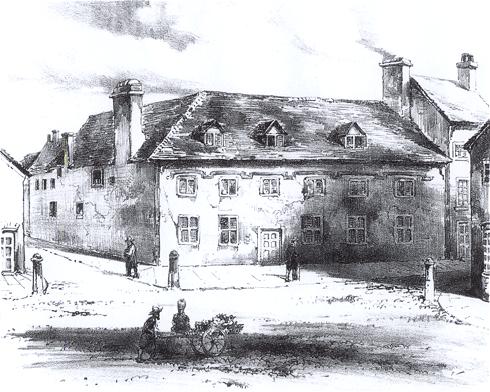
Doncaster House of Maintenance.
Courtesy of Doncaster Archives.
The initial intention appears to have been to provide the poor with work and various schemes were successively introduced — worsted weaving, cutlery making and sailcloth manufacture among them — with as little long-term success as similar schemes elsewhere. A copy of the rules for this institution produced in 1747 regulated the activities of the governing committee, the master and mistress of the workhouse and its inmates, and laid down a dietary:
Orders to be Observed by the Governors of the House of Maintenance for the Poor of Doncaster
|
Orders to be Observed by the Master and Mistress
|
Orders to be Observed by the Poor in the said House
| ||||||||||||||||||||||||||||||
Three parishes in the area of what became the Doncaster Poor Law Union — Bawtry, Barnby Dun and Tickhill — also established poorhouses. The regime in these on the eve of their dissolution is known from a report made to the West Riding court of quarter sessions in January 1836. The report also includes the workhouses at Fishlake, Hatfield and Thorne, parishes which were incorporated in the adjacent Thorne Poor Law Union.
Report on the Workhouses in the Lower Division Of Strafforth and Tickhill presented at Sheffield Sessions, October 1835, and thence Adjourned to Doncaster, January 1836.
The Power of Magistrates to order Relief out of the Workhouse being in a great Measure taken away by the recent Poor Law Act. I have pursuant to the Directions of... 30 G.3 c.49 visited the Workhouse in the Lower Division of Strafforth and Tickhill hereinafter named and respectfully report
The Schedule
Bawtry Workhouse visited 12th October, 1835.
Mr Nicholson and Mr Parkinson take the Poor in annual Rotation — and bring in a Bill.
Barmby Dunn [Barnby Dun] Workhouse visited October 25. 1835.
No stint in Bread or Potatoes — Tea when Sick.
Bake once a Week.
|
After 1834
Doncaster Poor Law Union was formed on 4th July 1837. Its operation was overseen by an elected Board of Guardians, 58 in number, representing its 54 constituent parishes and townships as listed below (figures in brackets indicate numbers of Guardians if more than one):
West Riding of Yorkshire:
Adwick-le-Street, Adwick-upon-Dearne, Armthorpe, Askern [Askerne], Austerfield, Awkley or Auckley, Balby with Hexthorpe, Barnbrough, Barnby upon Don or Barnby Dunn, Bawtry, Bentley with Arksey, Bilham, Blaxton, Bolton-upon-Dearne, Braithwell, Brodsworth-cum-Pigburn and Scawsby, Burghwallis, Cadeby, Campsall, Cantley,
Clayton with Frickley, Conisbrough, Denaby, Doncaster Borough (4), Edlington, Fenwick, Hampole, Hickleton, High Melton, Hooton Pagnell, Kirk Bramwith, Kirk Sandall and Trumfleet, Langthwaite with Tilts, Long Sandall with Wheatley, Loversall, Marr, Mexborough, Moss, Norton, Owston, Rossington, Skellow, Sprotbrough, Stainton with Hellaby, Stancill with Wellingley and Wilseck, Stotfold, Sutton, Thorpe in Balne, Thurnscoe, Tickhill (2), Wadworth, Warmsworth.
County of Nottingham: Finningley, Misson.
Later Additions: Carr House and Elm Field (from 1862).
The population falling within the Union at the 1831 census had been 31,728 with parishes and townships ranging in size from Stotfold (population 9) to Doncaster itself (10,801). The average annual poor-rate expenditure for the period 1834-36 had been £11,275 or 7s.1d. per head of the population.
Hexthorpe Lane Workhouse
In 1837, the Doncaster Board of Guardians purchased a 2.5 acre site in Hexthorpe, at the south-east corner of Hexthorpe Lane and Cherry, or Love, Lane. A Union workhouse was erected in 1839-40 at a cost of £8,000. In 1841, the old workhouse and vagrant office were sold off for £665. The architect of the new workhouse is not known and the building did not closely follow any of the popular workhouse plans of the period. A reception block with a central archway lay to the north. At the centre stood the main accommodation block, cruciform in layout, with a chapel at the north side. Boys' and girls' school blocks were placed the far sides to the west and east. An infirmary lay at the south of the site. The site location and layout are shown on the 1852 OS map below.
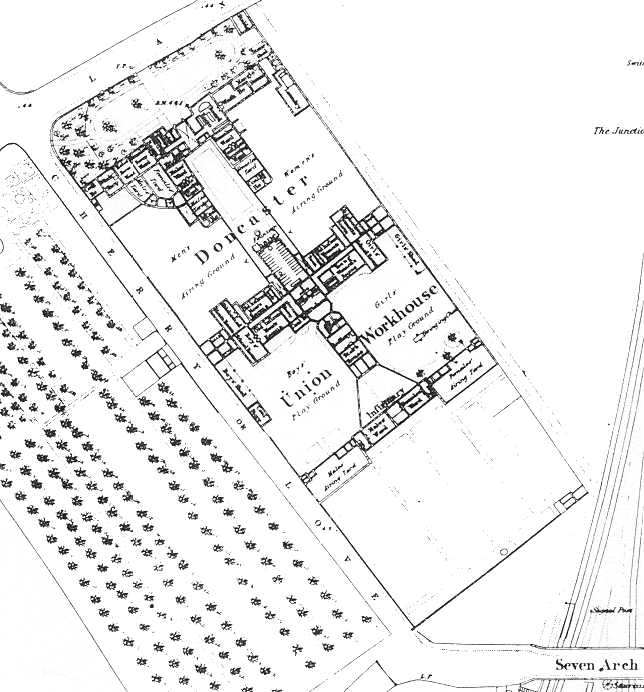
Doncaster Hexthorpe Lane site, 1852.
From 1853, the less-eligibility of the workhouse was progressively increased by its proximity to the industrial noise and smoke of the engineering works of the Great Northern Railway and the main north-south and east-west railway routes. This moved to Doncaster from Boston, Lincolnshire, in that year and, throughout the next half-century, continuously expanded its locomotive and railway-carriage building activities. Charles Hatfield, the owner-editor of a local newspaper editor, observed:
The approach to the workhouse is not particularly attractive: in its original state, it almost stood in the centre of green fields, fragrant orchards and cultivated gardens. It is now hemmed in on every side; and as the visitor advances towards it... he would imagine that it belonged to the Great Northern Railway Company. The railway runs close to it, shaking the very foundation... there is perpetual din and confusion, with smoke and dust, at times enough to stifle the robust.
Nevertheless, the Guardians continued to improve the facilities. In the 1850s and 1860s the infirmary premises were twice enlarged and new school rooms built. Major extensions were made between 1881 and 1883 at a cost of £6,472, more than three-quarters of the cost of the original buildings. These extensions and improvements were necessary because the population of the town was expanding rapidly in the second half of the nineteenth century, largely as the result of the expansion of railway engineering. Outside the town, however, the population of the union was in decline, as the opportunities in agricultural employment continued their long-term decline
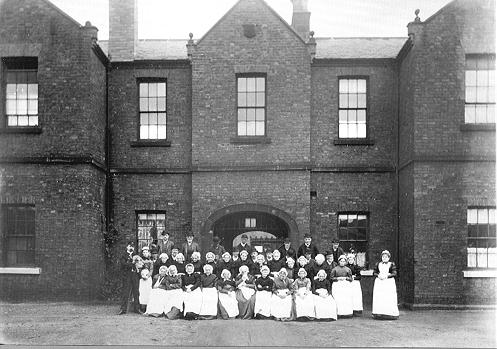
Doncaster Hexthorpe Lane entrance and inmates, 1890s.
Reproduced by kind permission of Doncaster Library and Information Services.
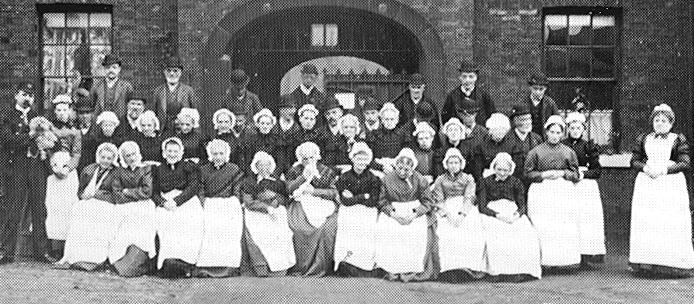
Doncaster Hexthorpe Lane inmates, 1890s.
Reproduced by kind permission of Doncaster Library and Information Services.
A description of the workhouse was provided in 1864 by William Sheardown:
THE UNION WORKHOUSE.
In 1837 the poor law guardians purchased for £690. two and a half acres of land in the Hexthorpe-road, on which was erected and finished in 1839 a Workhouse for the use of fifty-four parishes and townships.The building, built by Messrs. Lister, from designs by Messrs. Hurst and Moffatt, cost £8,000. including the fittings. The old workhouses, rented in the various townships, were given up. The one at Doncaster, a freehold of the township, was sold in 1841 for £330. The building will accommodate three hundred inmates, and is in the old English style, with pointed gables, having moulded stone copings, stone string courses dividing the stories, and stone plinths. In the centre is the chapel, which projects partly from the main building, and is a large, lofty, and well ventilated room, lighted by two long narrow round-headed windows on each side; and a large triplet window, with stone mullions, of the same character, at the west end. The chapel has two short galleries, and is fitted with a reading desk and benches. It is also used as a dining-room. The west gable is surmounted by a bell-turret. Over the chapel is a large room used as a lying-in ward.
The north side of the house is occupied by the females; the ground floor contains the matron's day-room, the infirm women, able-bodied women, and girls' day-rooms; the first floor has the school-mistresses' day-room, the infirm women, able-bodied women, and matron's bedrooms. The second floor is used for the female store-room, the schoolmistress' and girls' bed-rooms. The south side contains the master's office, and on the first floor the matron's work-room, the school-master's day-room, with the bed-rooms for males, corresponding with the side for females. The kitchen is situate at the back of the chapel, with a smaller kitchen, bread pantry, larder, and sculleries. The lodge buildings were built with accommodation for the porter, infectious ward, vagrant wards, and men's receiving ward, a probationary ward, and women's receiving and vagrant ward. There are baths and a supply of water. The wash-house, mangle-house, and laundry are part of these buildings. The girls have a wash-house for industrial instruction. The Infirmary is a large detached building, and is of two stories, with accommodation for the nurse, and a surgery. There are spacious exercising and work yards. A garden of about half an acre, is at the back, and is used for exercise for the sick. Behind the principal building, over the sculleries, &c. are boys' and girls' school-rooms, which were erected in 1859, at a cost, including Sittings, of £350. The infirmary was enlarged to its present state, in 1845, at an expense of £300. A sanitary improvement was effected in 1853, at an outlay of £393. by the drainage of the buildings and yards ; a plunging bath for the boys ; and making the girls' wash-house. Water was also conveyed by pipes for the premises, for the baths, and for flushing the drains. A new building was added in 1856, from a plan by Mr. Godfrey, as a fever ward; this cost £408.
The Workhouse was enlarged in 1863, by the addition of an infirmary for fever patients and other infectious diseases, rooms for attendants, and two new vagrant wards. This was effected by Mr. Godfrey, the architect, by raising and adding to the front entrance. Messrs. Wood and Son's tender was £600. for the building; Mr. Thrush, for plumbing and glazing, £54. 7s.
The rooms of the Workhouse are lofty and well ventilated, and are kept scrupulously clean, and everything proves it to be a well ordered establishment. The dietary is liberal, and care is exercised that the provision be of the best quality. The guardians rent three acres of land for the purpose of training the boys to industry, and the senior girls assist in the domestic arrangements when not engaged in the school.
There is one religious service on Sunday, and another on a week-day evening, besides the pastoral visits of the chaplain to the sick, the aged, and infirm, and his superintendence of the schools. The Holy Communion is administered.
In January, 1867, the workhouse received a visit from Poor Law Board inspector Mr HB Farnall. His report was rather less complimentary than Sheardown's and included the following comments:
The site of this house is become unsuitable, and its area too limited: it abuts upon the station of the Great Northern Railway, and the noise and smoke continually proceeding thence must be very trying and probably injurious to the sick, and very annoying both to the officers and the inmates generally.
The accommodation for the several classes of inmates is generally sufficient; but there are several defects in the internal arrangements of the house; for instance, the lavatories for the children require to be reconstructed; the arrangements for obtaining hot water both for domestic purposes and for the sick are insufficient; there are no separate sick wards for children: the windows in some of the sick wards are placed too high up in the walls. There are sick wards in the body of the house, and there are also detached fever and infectious wards, but patients with sore legs and offensive cases are sent to these detached wards, and it would, therefore, as it seems to me, be very unsafe to send bad fever cases to these wards.
The dinners for the sick who are in these detached wards, are sent from the body of the house, and cannot, therefore, be as hot as they should be; the room in which the clothes of the patients in these. wards are washed is far too small ; the floors of the receiving wards are of stone, and the re are no waterclosets attached to these wards; and there is only one bath for these wards, and that is in the women's receiving ward, and not in a room annexed.
The ventilation and means of lighting the wards are in a satisfactory condition.
The beds, bedding, and utensils are good, but the conveniences for washing are insufficient. The classification is tolerably complete; the diet, clothing, and employment of the inmates are good, but the means of affording recreation to the aged and infirm inmates are insufficient.
There are two paid nurses, but there should also be, as I think, two paid night nurses; for night nursing by paupers cannot be depended upon in the least.
The medical officer finds all the drugs but cod-liver oil; it would be more advantageous to the poor and the ratepayers if the Guardians found all the drugs.
I found 20 inmates who were not in communion with the Church of England; their ministers are permitted to visit them, and the Roman Catholics are allowed to go out to their place of worship. The schools are in the workhouse, and the children are generally separated from the adult inmates.
There is detailed information available about the diet on which the paupers were fed in Doncaster workhouse in the early 1860s. The different diets for able-bodied men and for able-bodied women and children aged from nine to sixteen are shown in the two tables. The only difference between the diets was that men received two ounces of bread a day more that the women and children and two ounces more suet or other pudding on Wednesday and Saturday. The elderly and infirm received a pint of tea instead of the milk porridge and five ounces of butter and seven of sugar each week, at the discretion of the Guardians. No diet was prescribed for children under nine years.
In 1995, a hospital dietician provided Doncaster Archives with comments on the dietary. As the precise details of the ingredients were not given, she could not provide a fully scientific assessment of the diet. It seems, though, that in the course of a week, that the able-bodied diets were providing an intake of more than the current recommended minimum level of both calories and protein. The level of vitamin C, however, would probably have been just under two-thirds of the current recommended intake, with the potatoes the only source. The diet for the elderly and infirm was not so nutritious. Both protein and calorie levels would have been lower with the substitution of tea for porridge, but would still have been comfortably above the minimum levels currently thought to be necessary.
Doncaster Workhouse: Dietary for Able-Bodied Men in the Early 1860s
| Sun | Mon | Tues | Wed | Thurs | Fri | Sat | |
| Breakfast | |||||||
| Bread (ounces) | 7 | 7 | 7 | 7 | 7 | 7 | 7 |
| Milk porridge (pints) | 1.5 | 1.5 | 1.5 | 1.5 | 1.5 | 1.5 | 1.5 |
| Dinner | |||||||
| Cooked Meat (ounces) | 5 | 5 | 5 | ||||
| Potatoes etc. (ounces) | 12 | 12 | 12 | ||||
| Soup (pints) | 1.5 | 1.5 | |||||
| Bread (ounces) | 3 | 3 | |||||
| Pudding, Suet etc. (ounces) | 14 | 14 | |||||
| Supper | |||||||
| Bread (ounces) | 7 | 7 | 7 | 7 | 7 | 7 | 7 |
| Cheese (ounces) | 2 |
Doncaster Workhouse: Dietary for Able-Bodied Women and Children
Aged 9 to 16 the Early 1860s
| Sun | Mon | Tues | Wed | Thurs | Fri | Sat | |
| Breakfast | |||||||
| Bread (ounces) | 6 | 6 | 6 | 6 | 6 | 6 | 6 |
| Milk Porridge (pints) | 1.5 | 1.5 | 1.5 | 1.5 | 1.5 | 1.5 | 1.5 |
| Dinner | |||||||
| Cooked Meat (ounces) | 5 | 5 | 5 | ||||
| Potatoes etc. (ounces) | 12 | 12 | 12 | ||||
| Soup (pints) | 1.5 | 1.5 | |||||
| Bread (ounces) | 3 | 3 | |||||
| Pudding, Suet etc. (ounces) | 12 | 12 | |||||
| Supper | |||||||
| Bread (ounces) | 6 | 6 | 6 | 6 | 6 | 6 | 6 |
| Cheese (ounces) | 2 | ||||||
| Milk Porridge (pints) | 1.5 | 1.5 | 1.5 | 1.5 | 1.5 | 1.5 |
A decade after the workhouse had been extensively renovated, the Guardians decided on the building of new premises at Springwell Lane, Balby, on the outskirts of Doncaster. The old workhouse was offered for sale in September 1901 and sold to the GNR for the extension of its works. The buildings were used for storage and were not demolished until the late 1960s.
Despite the original intention of the proponents of the new poor law rigorously to enforce the 'workhouse test', the majority of paupers continued to receive relief outside the workhouse. In Doncaster, for example, the statistics for both in-door and out-door relief were as follows:
| Year | Indoor relief | Outdoor Relief |
1840 | 171 | 1346 |
| 1845 | 272 | 1936 |
| 1860 | 159 | 832 |
| 1870 | 264 | 1049 |
| 1877 | 227 | 736 |
| 1878 | 268 | 732 |
The census of 1871 shows that those of working age were the minority in the workhouse. Over a third were aged up to fourteen and a similar proportion were over sixty years of age. The actual number of 'able bodied' were reduced by the presence of widows and the mentally and physically handicapped.
One of the children in the workhouse in 1871 was a twelve-year-old called John Broxholme. Charles Hadfield tells the story of how he was given his name:
A cruel desertion came to the knowledge of the writer in the summer of 1862. A hand carriage was observed on Thorne Road [Doncaster] coming from the direction of Wheatley Toll Bar, accompanied by a man and a woman. Soon afterwards, a boy, aged three years, neatly clad, was noticed alone in Broxholme lane. The little wanderer excited the compassion of a passer-by, and he was taken to the house of a god Samaritan in the Holmes. No enquiries were made for the stranger; a week elapsed, still no tidings were heard of its inhuman parents. Hence, an application was made to the Board of Guardians on Saturday, 19 July, and the facts elicited... The supposed parents were traced to Sheffield. Mr Jackson, the chief constable, discovered their whereabouts, but as it transpired that no marriage between them had been consummated, and that they were apparently destitute of visible means, it was deemed desirable to abandon all thoughts of prosecution. On 26 July the Workhouse Visiting Committee requested the Master to enter the child in his register 'John Broxholme'.
By the 1880s, tramsp and vagrants wishing to avail themselves of the workhouse casual ward had first to apply at the local police station, rather than just turning up at the workhouse. Having reviewed an applicant's circumstances, the police would issue a ticket to present at the workhouse.
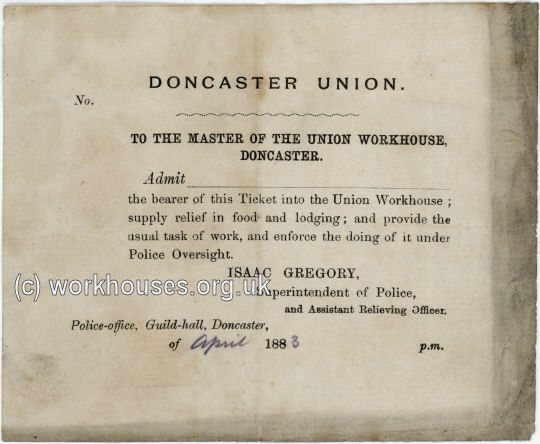
Doncaster workhouse casual ward ticket, 18830.
© Peter Higginbotham.
Springwell Lane Workhouse
The design for the new Springwell Lane workhouse was opened to competition with the successful entrant being JH Morton of South Shields who went on to design a workhouse for the nearby Hunslet Union. Springwell Lane, erected in 1897-1900, was intended to accommodate up to 600. It was based on a pavilion-block design with a central administrative building connected by corridors to separate blocks for the different classes of inmate.
At the official opening of the new workhouse in December 1900, the Chairman of the Guardians pronounced the buildings to be the most up-to-date in England and that their fame had spread so far that the Emperor and Empress of Russia had asked for the plans so as to build a similar establishment in their own country. He was given to understand that representatives of the Russian Government would visit the place.
The site layout and location, which in the 1890s was virtually rural, are shown on the 1930 map below. Workhouses throughout the country had, by this date, been renamed Poor Law Institutions as the result of an order of the Local Government Board in 1913.
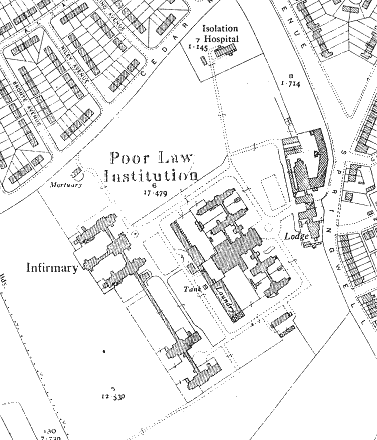
Doncaster Springwell Lane site, 1930.
The contract was made for building the new workhouse on 1 December 1897 and the work was completed in the autumn of 1900, although the official opening was delayed until 4 December through a problem over electrical installation. The Doncaster Gazette, 7 December 1900, includes a report of the official opening of the new workhouse. The new premises had cost £63,000, exclusive of the cost of the thirty-acre site and the furnishings and fittings, or about £70,000 in total. The buildings consisted of six distinct groups:
- the entrance building, containing the receiving wards, the vagrant wards, porter's accommodation and storage
- the main building (the workhouse proper), comprising a central administrative block with offices, master's house and dining room and, in pavilions on each side, accommodation for the 'male and female, aged and able-bodied classes' with day rooms, bath rooms and other facilities
- the laundry and boiler house building
- the infirmary building, with south-facing wards, nurses' accommodation, and dispensary
- the isolation hospital, self-contained on a remote part of the site, and
- the lunacy building, for 'imbeciles, epileptics, and short period lunatics' (the chronic cases were presumably transferred to the West Riding county asylums).
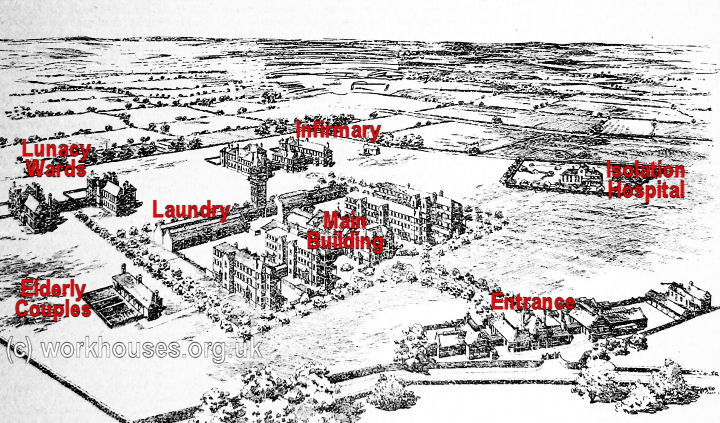
Doncaster Springwell Lane workhouse bird's-eye view from the east, c.1900.
© Peter Higginbotham.
There were also cottages for elderly married couples on the site, to the south of the main building, but 'entirely separate from it'.
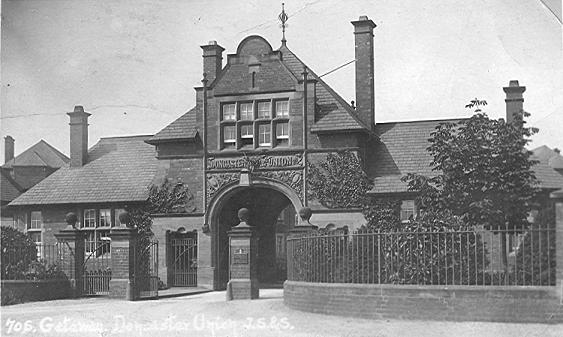
Doncaster Springwell Lane entrance building from the east, early 1900s.
Reproduced by kind permission of Doncaster Library and Information Services.
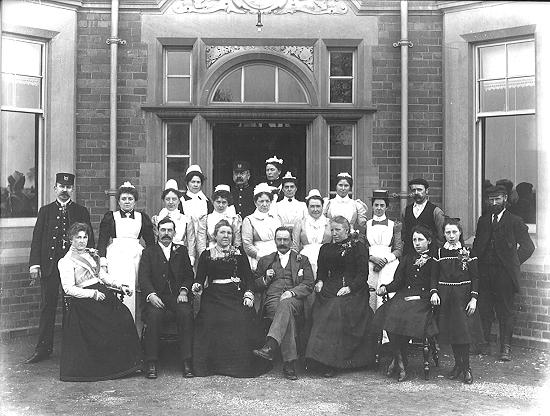
Doncaster Springwell Lane officers and staff, early 1900s.
Reproduced by kind permission of Doncaster Library and Information Services.
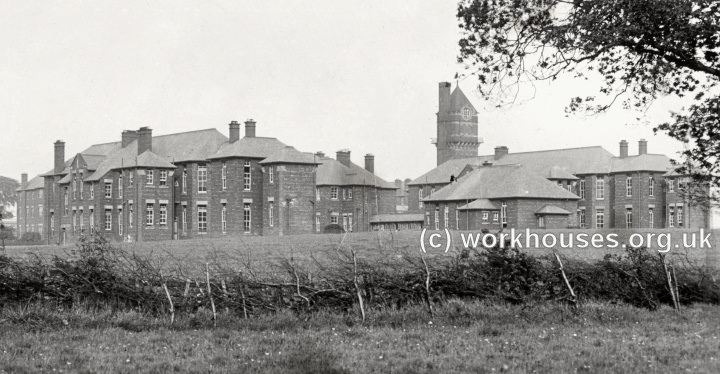
Doncaster Springwell Lane workhouse from the west, c.1905.
© Peter Higginbotham.
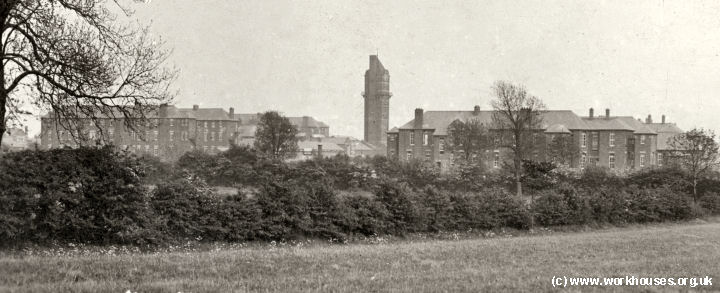
Doncaster Springwell Lane workhouse from the north-west, c.1905.
© Peter Higginbotham.
For part of the First World War, the workhouse was taken over for use by the military. In December 1914, thirty inmates from Doncaster were boarded out at the Wharfedale Union workhouse at Otley.
In November 1918, the master of the workhouse, Frank Owen, resigned after being convicted of being drunk in charge of a motor car and asaulting a police officer.
After the Local Government Act, 1929 abolished the Poor Law Guardians from 1 April 1930, responsibility for public assistance, and the former workhouse, fell upon Doncaster county borough council. The council renamed the premises Springwell House Public Assistance Institution. The buildings continued to function as a local authority hospital and provide accommodation for the destitute and for those who in the language of the period were classed as 'mentally deficient'. Initially, because of the 'poor quality of the accommodation' it was proposed not to adopt Springwell House as a hospital within the National Health Service. However, in the event the premises were taken over by the NHS and were designated as the Western Hospital in 1950. The hospital was used mostly for maternity and geriatric patients. It was demolished in 1974 and the site redeveloped for a primary school and private housing.
Staff
Inmates
Records
Note: many repositories impose a closure period of up to 100 years for records identifying individuals. Before travelling a long distance, always check that the records you want to consult will be available.
- Doncaster Archives, King Edward Road, Balby, Doncaster DN4 0NA. No records of the Doncaster Board of Guardians survive, but there are notes taken at their board meetings from 1862 to 1890 (although in a barely-decipherable hand) amongst the papers of William Aldam of Frickley, a local magistrate and ex officio member of the board. Surviving workhouse include registers of births and deaths from 1893, and registers of religious creed, in effect a record of all who were admitted to the workhouse, from 1904. There are also admission and discharge books for years 1934 to 1942. The contract plans of the new workhouse, dated 1896, are also available.
Bibliography
- The report to West Riding Quarter Sessions on the state of workhouses in 1835 in the Doncaster area appears in the proceedings of the Doncaster Sessions 13th January, 1836 amongst the quarter session records held at the West Yorkshire Archive Service Headquarters, Wakefield.
- Chadwick, Doncaster Workhouse (Ripon Museum Trust leaflet, 1996)
- Hatfield, C (c.1866) Historical Notices of Doncaster (Doncaster) - includes chapters on the poor law and workhouses and prints the workhouse dietary.
- Leigh, C (1987) British Railways from the Air - includes a photograph of the railway engineering works at Doncaster which shows the first workhouse, situated to the left of the railway bridge in the foreground.
- Sheardown, W (1864) The Doncaster Poor Law Union (Doncaster)
- Tomlinson, J (1887) Doncaster from the Roman Occupation to the Present Time - contains a nineteenth-century engraving of the eighteenth-century workhouse
- Tuffrey, P (1987)Balby with Hexthorpe (Stroud) - includes photographs of the demolition of both the first and the second workhouses.
Links
Acknowledgment
- Many thanks to Brian Barber at Doncaster Archives who contributed much of the material on this page, and Carol Hill at Doncaster Central Library.
Unless otherwise indicated, this page () is copyright Peter Higginbotham. Contents may not be reproduced without permission.


